Today’s Monday Morning Mojo is dedicated to the intersection of two concepts that make their way into our consciousness without many people noticing them. The first is the power of images, and the second is a behavioral science concept called the identifiable victim effect.
My inspiration for this comes from the below image I noticed in my social media feed. The image comes from the NFL Superbowl held on February 12th and the strategic, noble act of Kansas City Chiefs running back, Jerick McKinnon. Simply, McKinnon could have scored a touchdown to distance the lead against Philadelphia and become a Superbowl scoring running back, but rather he stopped at the goal line to help run the clock out. If he scored, Philadelphia would have had one more chance to score, but McKinnon’s selfless act prevented that from happening. I saw this image, and immediately I felt an even greater respect for McKinnon’s action. This image, and this act, which I also witnessed watching the game, will stay with me for a lifetime.
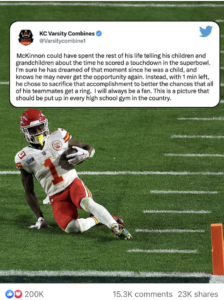
I’ve thought about the power of images a lot recently, as I am teaching a graduate communications course at University of Southern California and we just covered a section on the role of behavioral science in how messages are communicated and remembered. Thanks to the great work of my former boss and good friend, Chris Graves, who currently serves as the Founder and President of the Ogilvy Center for Behavioral Science, we talked a lot about the concept of “the identifiable victim effect”. Simply, this concept describes the tendency of individuals to have greater empathy when a specific, identifiable person (“victim”) is observed under hardship, as compared to a large, vaguely defined group with the same need.
While some images don’t involve hardship, per se, I feel the concept of identifying with an “individual”, as opposed to a group, has much better stickiness as a message. In the insightful book, “Made to Stick”, Chip and Dan Heath make a reference this concept as well. Perhaps the proverb, “A picture is worth 1,000 words,” should be tweaked to, “a picture of an individual with a story is worth 10,000 words.”
Here are six images that have made their way into my consciousness, with a brief explanation as to why.
The first is a picture of Alan Kurdi, a young Syrian boy, who was washed ashore in Turkey in 2015, fleeing the civil war taking place in Syria. Hundreds of thousands of Syrians were being displaced by Syria’s civil war, with few people taking notice. However, when the young Alan Kurdi’s picture appeared in global media, the whole narrative about the Syrian refugee crisis became even more urgent. This is one image clearly exemplifying the identifiable victim effect that will be remembered for years. To be clear, this is not inspirational, but rather it is insightful as it relates to the power of an image.
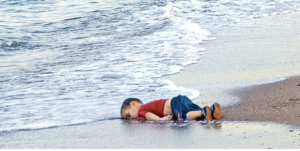
My wife, Lisa, brought this next image to my attention. Earlier this month, AFP’s Adem Atlan photographed father Mesut Hancer holding the hand of his daughter Irmak, 15, after she died beneath rubble in Kahramanmaras, near the recent Turkey-Syrian earthquake’s epicenter. The girl’s hand can be seen stretched out from underneath concrete slabs that collapsed on top of her during the fatal quake. Another image that tells the tragic story of what has taken place in this part of the world.
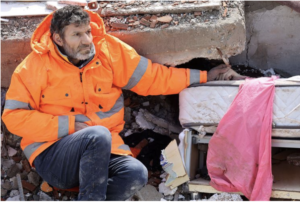
On a more positive note, sharing this famous image everyone has seen from mid-August, 1945, of a US Navy sailor kissing a nurse in Times Square at the close of World War Two. This image certainly has made its way into popular culture!
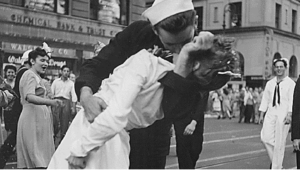
A personal favorite of mine from the sports world is an iconic photo of Columbian goalkeeper, Rene Higuita, in September 1995. In a friendly soccer match between England and Columbia, Higuita made a save which left everyone stunned. The scorpion kick is like a reverse hammer kick and extremely difficult to make. In my entire soccer career, I have never seen it happen. This image is priceless for me and I loved watching Higuita play.
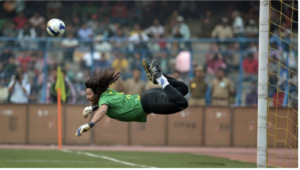
Another favorite of mine first appeared in 1985, when National Geographic featured Sharbat Gula from a refugee camp in Afghanistan on its cover as a symbol of the causalities of war taking place there. Thirty-six years later, in 2021, it was reported Gula was evacuated to Rome after Afghanistan fell under Taliban rule. I thought I would share a photo of Gula’s image 36 years later. This picture has stuck with me since it appeared, not only because of what it represents, but Gula in her youth faintly resembles my sister, Erin.
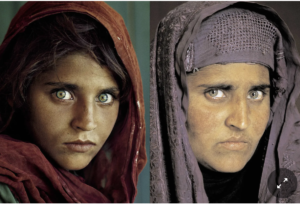
Finally, this image below from China reminds me of the photo of Sharbat Gula. In 1991, the Chinese government launched a program called, Project Hope, to focus on education for rural children. This photo of Su Ming Jun, who represented the program, touched many people and helped accelerate the success of the program. Some two million rural students were educated via Project Hope schools during the time. Fast forward to today, it was reported Su Ming Jun, pictured beside her childhood photo, finished college, and created a foundation dedicating her life to educating rural youth. A simple image with a great story behind it.


These are just six photos that combine the power of an image with the individual victim (or non victim) effect that make them that much more memorable. As I have spent my entire career in the communications business, we think a lot about lasting images. I hope this explains why many of these have been most memorable.
If you want to understand what makes a photo memorable and you have ten more minutes, have a read of this Atlantic article. I found this researching this post and enjoyed it.
Have a great week ahead.

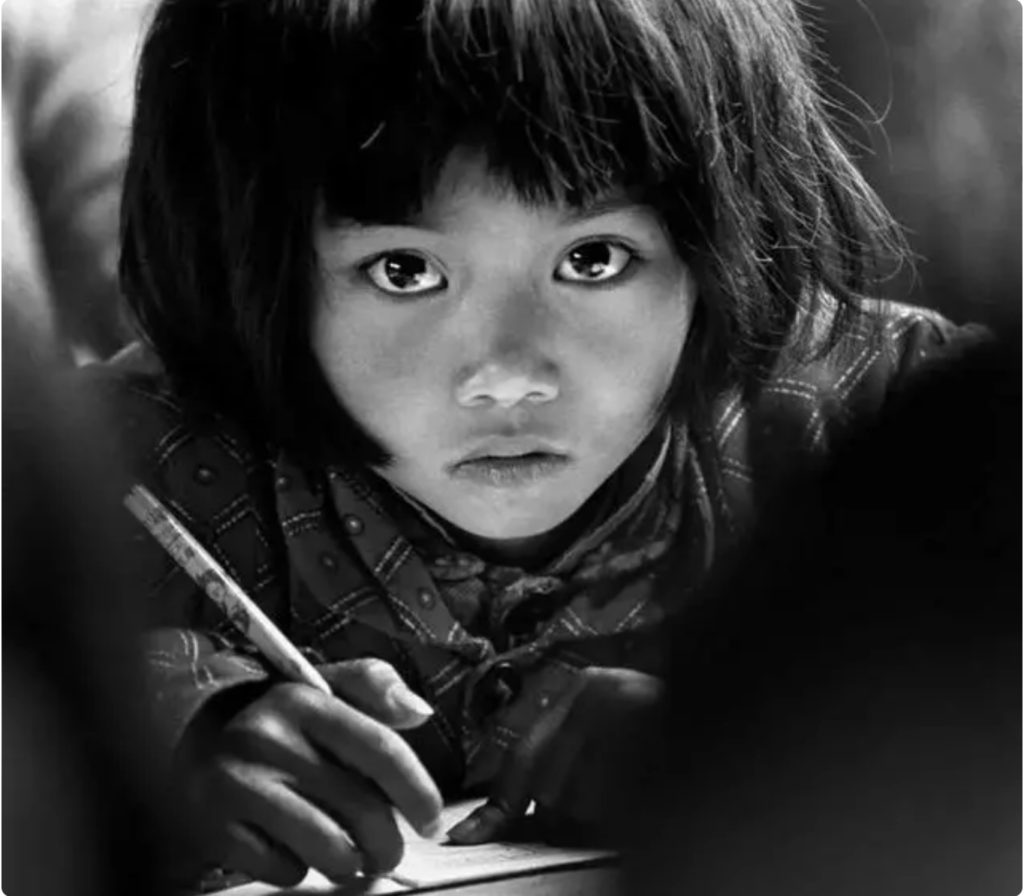


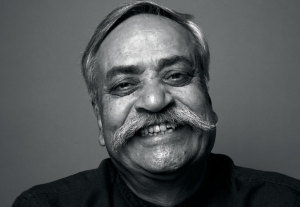
Thank you for sharing, Scott!
That’s Scott for sharing your professional background and inspiring us to see beyond the minds eye.
Dear Scott:
A very insightful article today. As I began reading it on my laptop I could not see the pictures until I scrolled down far enough to bring them up on the screen. After the first couple of paragraphs, I naturally thought of images I could remember and so it was no great surprise to find one of my favorites on the list. That of Sharbat Gula. Another aspect that interests me is that often that picture itself has an enormous effect on the subject forever changing the course of their life and again Sharbat serves as an example.
Thanks for sharing your thoughts.
Sergio
Hi Scott, Since I had not yet seen the father holding his trapped daughter’s hand; I couldn’t take my eyes off it. The father’s painful sorrow is written all over him.
As if the quake tragedy wasn’t enough tug at the heart strings, I read your words and, of course, I remember the picture. A young Syrian boy-child washed ashore, a victim of civil war. Then came the plea of a refugee’s pitiful fate that echoed around the world.
A quake and a civil war faced-off with two innocent children and won.
Aha, coming up last but not least… Your story about Gula, a casualty of the Afghanistan war, brought to life a refugee who’d escaped Taliban rule. I hope she enjoys a good life. Her beauty clearly made a connection with you to the extent you referenced your sister Erin. In that case, my guess is you speak of Gula’s stunning eyes. When Erin lived on Nanbru her eyes were gorgeous.